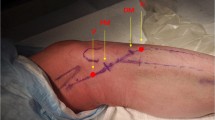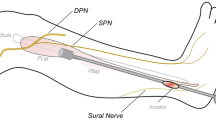Abstract
Background
After successful applications of the ultra-minimally invasive thread transecting technique (Guo Technique) for both thread carpal tunnel release and thread trigger finger release, we hypothesized that this technique could be used for superficial peroneal nerve release in the lower leg by selective crural fasciectomy. This study is aimed at testing the operative feasibility of performing the thread superficial peroneal nerve release (TSPNR) procedure in cadavers.
Methods
The TSPNR procedure was performed on 15 fresh frozen cadaveric lower-extremity specimens under ultrasound guidance. All cadaveric specimens were dissected and visually assessed immediately after the procedures.
Results
All 15 legs demonstrated a complete transection of the crural fasciae along the course of the superficial peroneal nerve (SPN) including where it penetrated and traversed the crural fascia. There was no evidence of any iatrogenic damage to the neurovascular bundle or adjacent tendons. The average operating time was less than 20 min.
Conclusion
This cadaveric study demonstrated that the technique of TSPNR was accurate, reliable, and feasible while causing no injury to adjacent neurovascular structures and avoiding having to make a skin incision. Further studies are warranted to verify the results of this study before implementing this new technique in the clinical setting.







Similar content being viewed by others
Abbreviations
- TSPNR:
-
Thread superficial peroneal nerve release
- SPN:
-
Superficial peroneal nerve
- TCTR:
-
Thread carpal tunnel release
- TTFR:
-
Thread trigger finger release
- D:
-
Distal point
- DM:
-
Distal margin
- P:
-
Proximal point
- PM:
-
Proximal margin
References
Balius R, Bong DA, Ardèvol J, Pedret C, Codina D, Dalmau A (2016) Ultrasound-guided fasciotomy for anterior chronic exertional compartment syndrome of the leg. J Ultrasound Med Off J Am Inst Ultrasound Med 35(4):823–829
Ducic I, Dellon AL, Graw KS (2006) The clinical importance of variations in the surgical anatomy of the superficial peroneal nerve in the mid-third of the lateral leg. Ann Plast Surg 56(6):635–638
de Fijter WM, Scheltinga MR, Luiting MG (2006) Minimally invasive fasciotomy in chronic exertional compartment syndrome and fascial hernias of the anterior lower leg: short- and long-term results. Mil Med 171(5):399–403
Franco MJ, Phillips BZ, Lalchandani GR, Mackinnon SE (2017) Decompression of the superficial peroneal nerve: clinical outcomes and anatomical study. J Neurosurg 126(1):330–335
Garfin S, Mubarak SJ, Owen CA (1977) Exertional anterolateral-compartment syndrome. Case report with fascial defect, muscle herniation, and superficial peroneal-nerve entrapment. J Bone Joint Surg Am 59(3):404–405
Grant TH, Omar IM, Dumanian GA, Pomeranz CB, Lewis VA (2015) Sonographic evaluation of common peroneal neuropathy in patients with foot drop. J Ultrasound Med Off J Am Inst Ultrasound Med 34(4):705–711
Guo D, Guo D, Guo J, Malone DG, Wei N, McCool LC (2016) A cadaveric study for the improvement of thread carpal tunnel release. J Hand Surg 41(10):e351–e357
Guo D, Guo D, Guo J, McCool LC, Tonkin B (2018) A cadaveric study of the thread trigger finger release: the first annular pulley transection through thread transecting technique. Hand 13(2):170–175
Guo D, Guo D, Guo J, Schmidt SC, Lytie RM (2017) A clinical study of the modified thread carpal tunnel release. Hand 12(5):453–460
Guo D, McCool L, Senk A, Tonkin B, Guo J, Lytie RM, Guo D (2018) Minimally invasive thread trigger digit release: a preliminary report on 34 digits of the adult hands. J Hand Surg Eur 43(9):942–947
Guo D, Tang Y, Ji Y, Sun T, Guo J, Guo D (2015) A non-scalpel technique for minimally invasive surgery: percutaneously looped thread transection of the transverse carpal ligament. Hand (New York, NY) 10(1):40–48
Henry AK (1973) Extensile exposure, Second edn. Churchill Livingstone
Kopell H, Thompson W (1963) Entrapment neuropathies. Williams & Wilkins, Baltimore, Maryland
KOPELL HP, THOMPSON WA (1960) Peripheral entrapment neuropathies of the lower extremity. N Engl J Med 262:56–60
Macaré van Maurik JFM, ter Horst B, van Hal M, Kon M, Peters EJG (2015) Effect of surgical decompression of nerves in the lower extremity in patients with painful diabetic polyneuropathy on stability: a randomized controlled trial. Clin Rehabil 29(10):994–1001
Mackey D, Colbert DS, Chater EH (1977) Musculo-cutaneous nerve entrapment. Ir J Med Sci 146(4):100–102
Mackinnon SE (2018) Superficial peroneal nerve release in the lower leg - extended. In: WUSTL learn surg. https://www.youtube.com/watch?v=OGBWww538oY
Malavolta M, Malavolta L (2007) Surgery for superficial peroneal nerve entrapment syndrome. Oper Orthop Traumatol 19(5–6):502–510
Marques Mansano A, Trescot A (2016) The role of peripheral nerve injections in the diagnosis and treatment of CRPS. Phys Med Rehabil Res. https://doi.org/10.15761/PMRR.1000121
Peer S, Kovacs P, Harpf C, Bodner G (2002) High-resolution sonography of lower extremity peripheral nerves: anatomic correlation and spectrum of disease. J ultrasound Med Off J Am Inst Ultrasound Med 21(3):315–322
Ray WZ, Mahan MA, Guo D, Guo D, Kliot M (2017) An update on addressing important peripheral nerve problems: challenges and potential solutions. Acta Neurochir 159(9):1765–1773
Rosson GD, Dellon AL (2005) Superficial peroneal nerve anatomic variability changes surgical technique. Clin Orthop (438):248–252
Saragaglia D, Farizon F, Drevet JG, Butel J (1986) Peroneal nerve entrapment syndrome of the front of the foot. Treatment by neurolysis. Apropos of a bilateral case. Rev Chir Orthop Reparatrice Appar Mot 72(8):579–581
Styf JR, Körner LM (1986) Chronic anterior-compartment syndrome of the leg. Results of treatment by fasciotomy. J Bone Joint Surg Am 68(9):1338–1347
Styf J, Morberg P (1997) The superficial peroneal tunnel syndrome: results of treatment by Descompression. J Bone Jt Surg 79-B(5):801–803
Yang LJS, Gala VC, McGillicuddy JE (2006) Superficial peroneal nerve syndrome: an unusual nerve entrapment. J Neurosurg 104(5):820–823
Acknowledgements
The authors would like to thank Dennis Dykstra, M.D., Ph.D. for his ongoing support.
Author information
Authors and Affiliations
Corresponding author
Ethics declarations
Conflict of interest
Two of the authors, Danzhu Guo and Danqing Guo, are brothers to Joseph Guo who is the inventor of the Loop & Sheer thread. All other authors certify that they have no affiliations with or involvement in any organization or entity with any financial interest (such as honoraria; educational grants; participation in speakers’ bureaus; membership, employment, consultancies, stock ownership, or other equity interest; and expert testimony or patent-licensing arrangements), or non-financial interest (such as personal or professional relationships, affiliations, knowledge or beliefs) in the subject matter or materials discussed in this manuscript.
Ethical approval
All procedures performed in studies involving human participants were in accordance with the ethical standards of the institutional and/or national research committee and with the 1964 Helsinki declaration and its later amendments or comparable ethical standards.
Additional information
Publisher’s note
Springer Nature remains neutral with regard to jurisdictional claims in published maps and institutional affiliations.
This article is part of the Topical Collection on Neurosurgical technique evaluation
Electronic supplementary material
The arrow indicates the superficial peroneal nerve as it courses distally piercing through the crural fascia, and the moving white dots above the superficial peroneal nerve are the thread looping the crural fascia (MP4 7976 kb)
Rights and permissions
About this article
Cite this article
Guo, D., Guo, D., Harrison, R. et al. A cadaveric study using the ultra-minimally invasive thread transection technique to decompress the superficial peroneal nerve in the lower leg. Acta Neurochir 161, 2133–2139 (2019). https://doi.org/10.1007/s00701-019-03944-y
Received:
Accepted:
Published:
Issue Date:
DOI: https://doi.org/10.1007/s00701-019-03944-y




